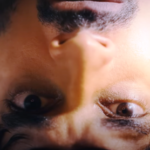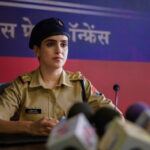This was a film whose release was deferred by the authorities because of the General Elections. I feel that the way it is narrated, they need not have bothered. Even the real conclusion is told in a way as if it did not matter much in the overall context! The Godhra massacre seems to be sent to the background here in a movie that, probably inspired more by media battle and ethical journalism stories and on a mission to be “politically correct”, wants to focus more on media coverage as an aftermath to real tragedies.
Basically, the film thus veers off at a tangent where the media is spotlighted more, and there seems to be only one publishing house of significance—something called EBT News—in the entire country, which supports a certain political party (not mentioned by name!) that intends to exploit the ghastly 2002 Godhra massacre as a means of gaining votes by targeting the opposite party.
The film begins with a court case filed against the honest Hindi journalist, Samar Kumar (Vikrant Massey) who selflessly got to the bottom of the truth with the Sabarmati Report (the title of the film) though he had to lose a lot because of his principled stand, including his girlfriend (Barkha Singh). So who has filed this case? Is it the dicey media house or the party in collusion with it? There are no answers given!
Samar has the guts to film his own interviews with the victims when he visits the site of the burnt train as photographer along with ‘programmed’ EBT ace reporter, Mahika (Monica Dogra), who has already been instructed to show that the fire in the train was an accident. Mysteriously, no other channel or newspaper seems to be covering the ghastly incident that remains a blot on modern-day India!
Samar’s cassette is kept “safely” by a worker in the EBT office and we do not know why the EBT bosses did that as they could have destroyed it! Five years (!) later, the worker’s conscience “wakes up” when a change of circumstances leads to the Godhra case being reopened.
The man says that he has “made copies of certain cassettes that were ordered to be destroyed” (!!) and helps rookie journalist Amrita (Raashii Khanna) by telling her about Samar, now unemployed, debt-ridden, yet an obsessive drunkard, when she is asked to file a story on Godhra again, as per specification.
And Amrita, till then a fan of star reporter Manika, finds Samar easily and decides to go on a fact-finding trip to Godhra. Over there, the way things are shown, the duo (Samar stops alcohol overnight after five years of non-stop drinking!), big monies easily managed, find out facts with amazing ease, and expose the shocking truth.
More questions: Why is Amrita missing from court? What happens to Mahika and EBT News? And why does the film pitch the English media versus the Hindi media as dishonest and honest respectively? Really! Is it all so simplistic??? Are not good eggs and rotten ones existing on both sides?
I could go on and on. The story seems to be more of a The Samar Versus Mahika Reportrather than a biting thriller or a searing and honest docu-drama on a macabre and venomous incident. In their bid to be politically correct and “sensitive” to both the communities involved in the real story (where the Nanavati Commission found out facts on the basis of which 31 were found guilty for arson and pre-planned arson and murder and 11 of them were sentenced to death), the makers project one of the worst massacres in free India to become almost incidental in a fictional media ethics saga.
I am told that director Rajesh Chandel quit his association with the film over its content and I think that his concept and execution must have been much better! But that is just a premise, an assumption. And this film makes so many, anyway!
In concept and execution, the film goes woefully wrong, and wrings attention away from the sheer inhumanity of the perpetrators of the crime and the way it was exploited by a caucus of politicians and media later. Godhra: Accident or Conspiracy, released earlier this year, was a far more honest recount of the 2002 tragedy, despite the add-on elements of fiction for dramatization.
Here, the real facts are presented almost timidly, and the fiction unimaginatively done except for the sequence where, like a good detective, Samar pieces together two theories propagated by interested parties and arrives at the conclusion that both are a bundle of planned lies. This part has its limited entertainment quotient for the viewer. However, the sops offered, like an upright girl from the offending community and the cricket match incident, are not really effective, or would have been so had the context been different and fictional. And the way the “mastermind” of the ghoulish act is tackled and ‘set right’ is absurd, to say the least!
Vikrant Massey saves the situation to an extent by getting his emotional pacing right throughout. He comes across as an intense hunter for the real truth, not what has to be projected as “truth” by dishonest media houses that prosper because of the support of wrong powers. Raashii Khanna is alright in an undemanding role, while Monica Dogra, though effective as the dictatorial and arrogant Mahika, almost ends up as a 1970s-1980s negative female character. The rest of the cast has nothing to do.
If at all the film works a bit, it is as a “righteous” movie that talks of evil and good existing on both sides of the communal spectrum (wish they had told this truth about the media as well!!) and hints at moving on. Never mind if this is the fifth or sixth Indian movie that revisits Godhra.
Balaji Telefilms’ & Vikir Films’ The Sabarmati Report Produced by: Shobha Kapoor, Ekta Kapoor, Amul V. Mohan & Anshul Mohan Directed by: Rajesh Chandel & Dheeraj Sarna Written by: Arjun Bhandegaonkar, Avinash Singh Tomar, Vipin Agnihotri & Dheeraj Sarna Music: Kartik Kush, Akhil Sachdeva & Arko Starring: Vikrant Massey, Raashii Khanna, Monica Dogra, Nazneen Patni, Hella Stichlmair, Aryan Ardent, Sundip Ved, Prince Kashyap, Sandeep Kumar, Rohit Ameriya, Anjali Nadig, Tushar Phulke, Sp. App.: Barkha Singh & others.
(Used with permission)






